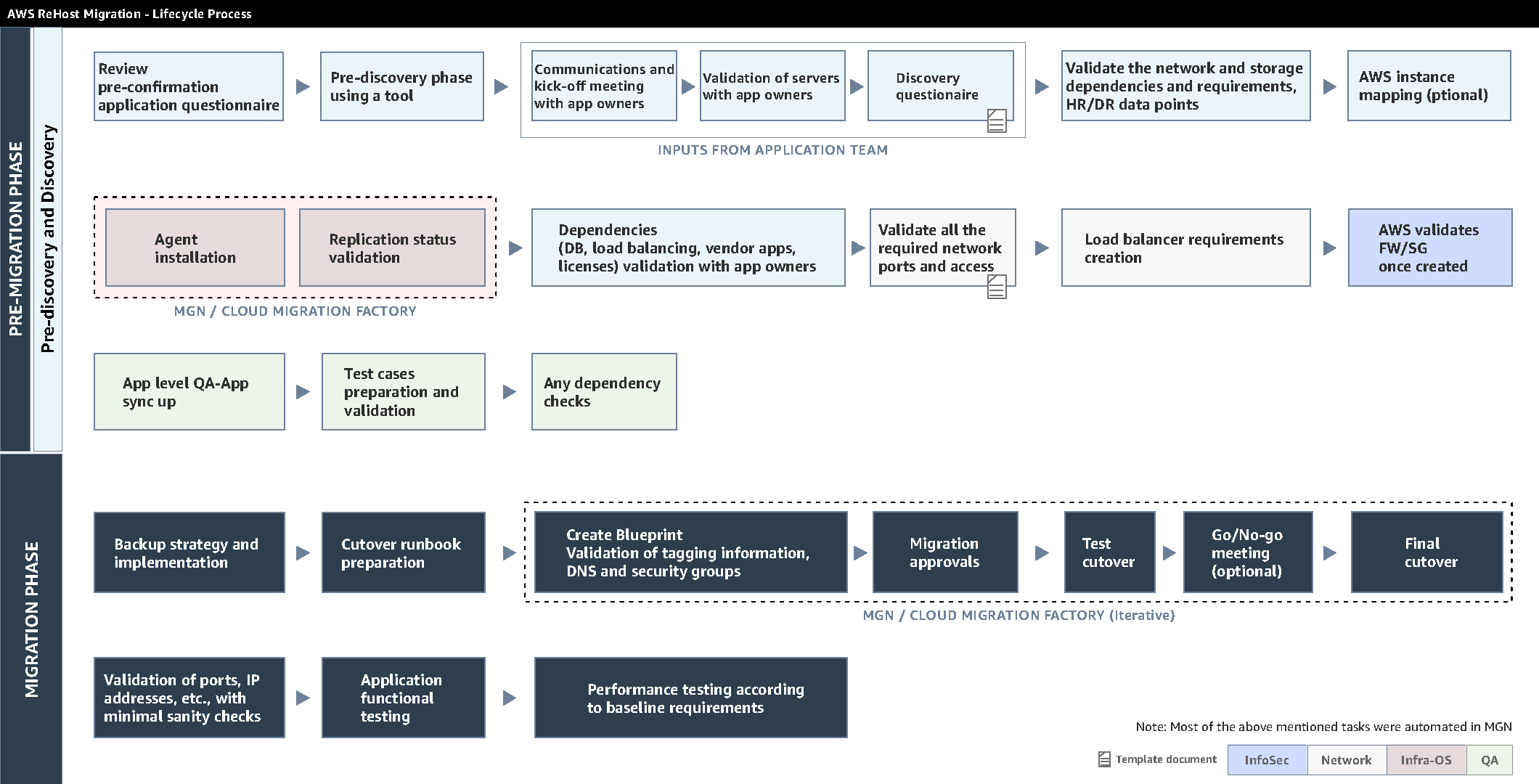The migration process
The three-phase migration process is designed to help your organization’s migration of tens, hundreds, or thousands of applications.

While each phase is a common component of a successful migration, they are not discrete
phases, but an iterative process. As you iterate and migrate more applications, you can
drive repeatability and predictability in processes and procedures, and you might find that
the migration process accelerates. For more information about the three-phase migration
process, see How to
migrate
The rehosting migration process with AWS and Cloud Migration Factory
Rehosting on-premises workloads on the AWS Cloud involves several migration phases: planning (the assess phase), pre-discovery and discovery (the mobilize phase), and building, testing, and cutover (the migrate phase).
The following diagram outlines, at a high level, the phases and their related tasks, grouping the phases into pre-migration and migration.

These tasks support about 75 percent of all application workloads. The tasks can be implemented over 2-3 weeks, in an agile sprint cycle.
The planning phase
Review and vet these tasks with your migration team and an AWS migration specialist or AWS Partner consultants. After the review, do the following:
-
Gather the inputs
-
Eliminate or re-evaluate tasks as necessary to meet your requirements
-
Modify other tasks to support at least 75 percent of the application workloads in your portfolio
To conduct the AWS initial assessment, build a proof of concept in a test environment so that you can assess the operating cost and workload performance. An AWS Migration Specialist can help you with this step. This approach helps you to calibrate, assess, and compare services such as storage formats, databases, compute types, and networking offered by AWS and other cloud service providers.
Pre-discovery and discovery phase
In this phase, the migration specialist from AWS reviews the pre-confirmation app questionnaire with the line of business. The specialist also conducts interviews with application owners to validate the server inventory by going through a series of discovery-related questions. While completing the discovery questionnaire, the AWS specialist does the following:
-
Validates the network and storage dependencies and requirements
-
Validates high availability/disaster recovery (HA/DR) data points
-
Obtains the current state diagram for the application
-
Creates a logical diagram that shows the target state
-
Gets server information
-
Identifies server groups
-
Adds any missing server details
-
Tries to map the target AWS instances.
The migration phase
The Application Migration Service agent is installed on all the servers that are planned for rehost migration. After the agent is installed, continuous data replication (CDR) status is tracked for each server. These steps are automated in Application Migration Service.
For each application, the AWS migration specialist checks for dependencies, such as databases, load balancers, vendor applications, and licenses, and validates them with the application owner. The migration specialist also validates inbound/outbound network ports and access, creates load balancer requirements, and validates the firewall, subnets, and security groups at AWS. In parallel, the application’s QA team prepares and validates the test cases, and checks for any dependencies.
During the migration phase, the backup and DR strategy is developed before setting the cutover schedule. Sometimes, this step is planned before the pre-discovery phase or even before rehosting is chosen as the migration strategy. The AWS migration specialist does the following:
-
Creates the cutover runbook document, and validates it with the stakeholders
-
Validates the Application Migration Service blueprint, tag information, Domain Name Service (DNS), and security groups
-
Obtains migration approvals from stakeholders
-
Performs test cutover followed by the final cutover
This is an iterative mechanism, and all these steps are performed for each cutover in Application Migration Service. After the cutover, ports, IP addresses, and so forth, are validated. Application-level sanity checks or testing can be initiated by application owners according to baseline requirements.
This flow works for both the Application Migration Service and the Cloud Migration Factory approaches. For more information, see the Rehost on-premises workloads in the AWS Cloud: migration checklist AWS Prescriptive Guidance pattern.